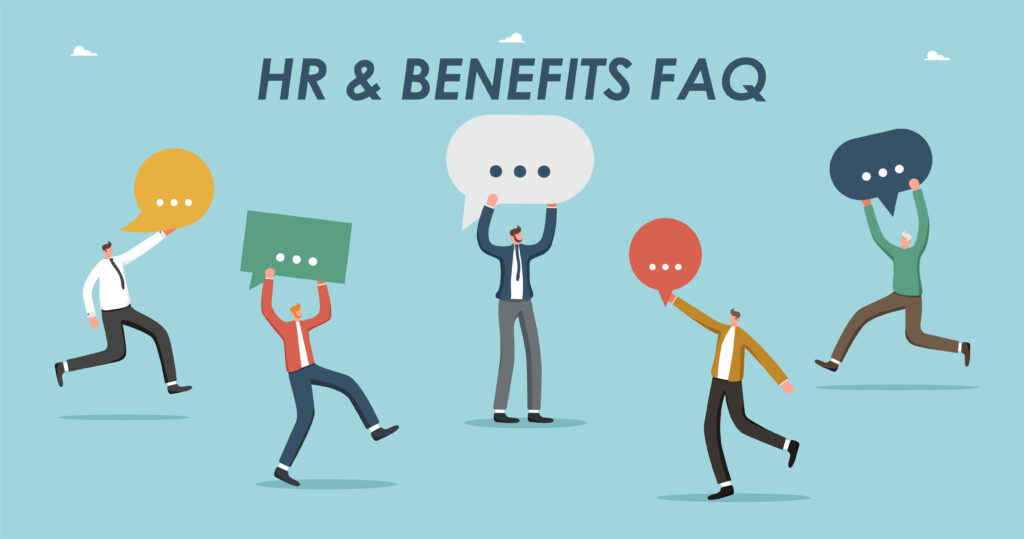Employee Benefits Deduction Calculations

Determining an employee’s Insurance Deduction Calculations isn’t always a lot of fun. They say, “It’s math, not magic!” But some days it feels like you need magic to make the math work! Although on occasion tedious and daunting, making sure calculations are correct is essential for both employee and employer.
Deduction calculation adjustments happen at renewal time, as well as any time an employee comes on or off a plan mid-year or makes changes. If an employer changes how much they contribute to premium, the employee calculation will also need adjusted.
How to make deduction calculations? First, you need to determine several items, preferably in tandem with your accounting department.
- Are deductions paid for the current month or paid in the month ahead? If possible, we recommend paying in the current month so that if an employee leaves, they haven’t overpaid.
- Are deductions calculated on a monthly or annual basis? Your accounting team may have a preference.
- Either way there may be ‘odd’ pennies, so let your accounting team know when to expect them.
- If calculating monthly, in months with an extra payroll (5 for weekly or 3 for bi-weekly) those ‘extra’ payrolls will not get a deduction.
- If calculating on an annual basis, there will be a deduction for each payroll.
- Odd pennies: it is unlikely that your employee premiums will be perfectly divisible by year or month, so you will need to decide when to charge these. We do ours at the beginning of the plan year or beginning of the month.
- Some deductions are weekly; these do not require calculating the deduction. Examples include: 401ks and Long-Term Care.
- Some deductions are weekly but may require calculating the deduction to allow the employee to max out their coverage. Examples include: HSAs and FSAs.
You will then need to calculate the deductions.
Sample calculations for weekly payroll:
Dental (monthly premium – calculated on a monthly basis)
- $40.25 (sample premium)
- 4 weeks/month: $10.06/week ($40.25/4) – if there’s a fifth paycheck, no deduction is taken
- Annual premium: $483/year (40.25*12)
- Determine odd pennies
- 4 months have 5 Fridays, and only 48 deductions should be taken
- $10.06 * 4 = $40.24
- $40.25 – $40.24 = $0.01
- First deduction of each month should be: $10.07
- $10.06 + $0.01 = $10.07
- If an employee is only eligible for 11 months, you would use 11 months and 44 weeks to calculate the total.
HSA (annual maximum – calculated on an annual basis)
- $4,400 (individual 2026 maximum) – keep in mind the family maximum is higher, individuals age 55+ can put in an additional $1,000/year, any employer match comes out of the maximum, and an eligible employee can put in any amount up to the maximum.
- $4,400/52 = $84.61 (to max out the HSA for the year with a weekly payroll)
- Determine the odd pennies for maxing out the deduction
- $79.8 * 52 = $4,399.72
- $4,400 – 4399.72 = $0.28
- First deduction should be $84.89
- $84.61 + $0.28
After deduction calculations are completed, you need to communicate them to employees. We recommend the use of a payroll deduction worksheet, which includes all benefits and requires an employee’s signature; this allows you to have documentation of employees’ elections in the event of a dispute.
Contact Us
HR & Benefits FAQ

Below are several items you will want to have noted somewhere for internal purposes. Here is where you might find them internally:
1. What is your corporate structure, EIN, and date of inception?
a. Someone in accounting or senior leadership, old tax documents, or old insurance or 401k applications may have this data.
b. You may want to keep a document that includes this and other important but rarely used information close at hand.
c. If you’ve had a merger or corporate structure change, you’ll want to make sure you’re using the current information on all documents, and there may be a bit of clean-up over time.
2. What to do if your corporate structure isn’t listed on an application or form?
a. Write it in by the question and then note it in the cover letter or email you send the document with.
b. Reach out to the vendor (or your broker) if the above isn’t an option and ask them where they want it or what information they want instead.
3. How many ERISA 500 plans do you have?
a. These are numbered sequentially and may include your 401k plan, wrap documents, section 125 (POP), pension, HRA, and more.
i. Your 401k plan may have a ‘500’ number that doesn’t begin with ‘5’ such as ‘001’ or ‘002’. This is acceptable.
b. Plan numbers can’t be reused even if a plan has ended, so you may need to comb through your plan documents.
i. A note: if you have a corporate structure change (new EIN) or merger, plan numbers are tied to the new business, not to any now-defunct businesses.
c. Any 5500 filings you have completed list plan numbers, so your accounting or tax team may be able to help as well. (Not all plans need to file 5500s.)
d. We recommend creating a document with which plan is assigned to each number so that you don’t repeat. Be sure to include any old plan numbers and mark them as inactive but don’t reuse them.
e. If you have inadvertently used a plan number more than once, we recommend reaching out to your tax or ERISA attorney. There may be an easy fix.
4. Where is your plan information stored internally?
a. Ask senior leadership if you aren’t sure.
b. If you can store data electronically, we recommend that you do so.
c. Keep in mind that many plan documents should be stored for 7 years after the plan (or coverage) ends, so you may want an archive file.
d. If you are missing anything on plans we administer, please reach out and we’ll get it to you.
e. Once you know where plan information is stored and have it filed, make sure someone else on your team also knows where to find it and who to reach out to for updated documents.
i.CUIS will proactively reach out to you if we receive any updated plan documents relating to your plans through us.
5. What is your payroll deduction schedule?
a. This impacts how the formulas for premium deductions are calculated and spread out, as well as when to start deductions for a new hire and stop deductions for terminations.
b. How often? – usually this is tied to payroll frequency (weekly, biweekly)
c. Spread – are calculations done on a monthly or annualized basis?
i. Your accounting team may know how this is done if you aren’t sure since they’ll use this information in your financials.
d. What do you do for months with an ‘extra’ payroll (5 weeks or 3 biweekly)?
e. Do you take premiums for the current or upcoming month?
i. You may be able to determine this by looking at your payroll system OR by looking at when deduction changes were made for the last benefits renewal.
6. How much do you contribute towards various plan premiums?
a. This is probably discussed during budgeting each year, so reach out to someone who was involved in those discussions.
b. Your accounting team may know for budgeting purposes as well.
c. Check your employee deduction worksheets to see if the information is listed there for employees’ knowledge.
Here’s Where We Can Help Our Clients:
1. Education for ‘new’ HR personnel – new to CUIS, new to the employer, or new to HR. We would like to schedule an initial education session with recurring follow-ups at a time that works best for you and our team. These cover benefits through us, benefits compliance, legally required documentation, and more.
2. New hire benefits education.
3. Renewal meetings with leadership to determine the best plans to meet your company’s needs for the coming year. We can help you get creative to care for your employees and your company finances.
4. Renewal education for employees.
5. Webinars on benefits-relevant topics – we’ve covered total compensation statements, Medicare education for employees (recurring) and employers, Maine PFML, and more in the past.
6. Mediate claims and billing issues.
Contact Us
Who is CU Insurance Solutions (CUIS)

CU Insurance Solutions (CUIS) is a Maine-based CUSO insurance agency specializing in Lending, Member, Employee Benefits, and Commercial Insurance and Protection programs. As a CUSO, we are governed by a board of managers comprised of 9 credit union professionals who represent our credit union member-owners. Our current owners comprise 48 Maine credit unions, as well as 2 credit unions in greater New England.
CUIS was originally founded in 1963 by the Maine Credit Union League as a trust with all of Maine’s credit unions as beneficiaries. At the time, the Maine Credit Union League Insurance Trust (MCULIT) was primarily focused on member products to provide credit unions with programs that weren’t otherwise available. Over time, our name and structure have evolved: MCULIT became Insurance Trust, which became CUIS, a trust transformed into a CUSO. However, our goal has remained the same: to support those who support others. We strive to continually provide competitive marketplace options that enable credit unions to remain protected, successful, and independent while offering cost-effective and industry-leading solutions.
If your Credit Union is an owner or partner of CUIS, that means we work with and for you!
What are the benefits of working with and being an owner of CU Insurance Solutions?
New Solutions
We are dedicated to continually adapting to provide creative solutions for the challenges credit unions face today. Our team and Board of Managers are committed to keeping our mission alive by fostering relevant and sustainable insurance and financial program options for Maine’s credit unions.
Solutions to help your credit union…
- Explore alternative product options in the CU marketplace
- Find crucial cost savings that help improve the bottom line
- Protect credit union assets and safeguard members
- Create revenue streams to ensure continuous growth
If your credit union needs a specific solution or has a suggested program in mind, please let us know.
Programs for Your Members
From GAP & Vehicle Service Contracts to Credit/Debt Protection, we provide competitive programs that are designed to help your credit union generate, retain, and protect your loans and members.
From AD&D and Life Insurance to Identity Theft Protection and Will/Estate Planning, we offer comprehensive solutions to provide your members with the best coverage options to meet their needs while allowing your CU to increase non-interest income.
Employee Benefits
If we are your employee benefits broker, we are available to answer any questions you have as an employee. We can help with escalated claims issues, answering questions about who to go to for a network issue, advising on your wellness apps, determining which plan offered by your employer is best for you and your family, and explaining how HSAs and HRAs work. We also have a relationship with a Medicare specialist if you or a loved one needs help navigating that.
Training Support
We have a dedicated trainer who provides no -cost product knowledge education that is customized for you and your teammates in the format that works best for you: in person, group, web, recorded trainings, etc. We also hold an annual lending workshop.
Ongoing Educational Webinars
We offer no-cost quarterly webinars – 2 focused on HR/benefits-related topics and 2 focused on member/lending topics. These are recorded and available to you at any time.
Newsletters
We provide a monthly Benefits Newsletter as well as a quarterly Lending Newsletter. These are available to any staff either via your HR or head of lending or by reaching out to our team.
Community Engagement
Our team attends nearly every chapter meeting, financial fitness fairs, and many fundraising events each year. We also lead a Social Responsibility Committee comprised of CU, CUIS, and Synergent employees that works with Special Olympics of Maine – volunteering and raising money. We are always looking for new ways to give back.
Annual Distributions
Ownership also means that CUIS provides your member-owner CU with the opportunity to share in both pro-rata and proportional distributions based on a board-approved amount of net income earnings annually. In 2024, $400,000 was distributed to our owners based on our first year of income as a CUSO. The better CUIS does financially, the more we’re able to share back.
Contact Us
Deduction Calculations

Article by Elizabeth Ingram
VP of People Strategy – CU Insurance Solutions
Determining an employee’s Insurance Deduction Calculations isn’t always a lot of fun, but making sure they are correct is essential for both the employee and employer.
Deduction calculations happen at renewal time (before and after), as well as any time an employee comes on or off the plan mid-year OR makes changes. If the employer changes how much they contribute to premium, the employee calculation needs to be re-done as well.
How to make deduction calculations? First you need to determine several items, preferably in tandem with your accounting department.
- Are deductions paid for the current month or paid in the month ahead? If possible, we recommend paying in the current month so that if an employee leaves, they haven’t overpaid.
- Are deductions calculated on a monthly or annual basis? Your accounting team may have a preference.
- Either way there may be ‘odd’ pennies, so let your accounting team know when to expect them.
- If calculating monthly, in months with an extra payroll (5 for weekly or 3 for bi-weekly) those ‘extra’ payrolls will not get a deduction.
- If calculating on an annual basis, there will be a deduction for each payroll.
- Odd pennies: it is unlikely that your employee premiums will be perfectly divisible by year or month, so you will need to decide when to charge these. We do ours at the beginning of the plan year.
- Some deductions are weekly; these do not require calculating the deduction. Examples include: 401ks and Long-Term Care.
- Some deductions are weekly but may require calculating the deduction to allow the employee to max out their coverage. Examples include: HSAs and FSAs.
You will then need to calculate the deductions.
Sample calculations for weekly payroll:
Dental (monthly premium – calculated on a monthly basis)
- $40.25 (sample premium)
- 4 weeks/month: $10.06/week ($40.25/4) – if there’s a fifth paycheck, no deduction is taken
- Annual premium: $483/year (40.25*12)
- Determine odd pennies
- 4 months have 5 Fridays, so only 48 deductions should be taken
- $10.06*48=482.88
- $483-482.88=0.12
- First deduction should be: $10.18
- $10.06+0.12=$10.18
- If an employee is only eligible for 11 months, you would use 11 months and 44 weeks to calculate the total.
HSA (annual maximum – calculated on an annual basis)
- $4150 (individual 2024 maximum) – keep in mind the family maximum is higher, individuals age 55+ can put in an additional $1000/year, any employer match comes out of the maximum, and an eligible employee can put in any amount up to the maximum.
- $4150/52=$79.8 (to max out the HSA for the year with a weekly payroll)
- Determine the odd pennies for maxing out the deduction
- $79.8*52=$4149.60
- $4150-4149.60=0.40
- First deduction should be $80.20
After deduction calculations are made, you need to communicate them to employees. We recommend the use of a payroll deduction worksheet which includes all benefits and requires an employee signature.
Employee Benefits Nondiscrimination Testing

If you offer any pre-tax employee benefits, you need to have a Section 125 (also known as a POP or Cafeteria Plan) in place. These benefits may include your medical, dental, vision, life, disability, voluntary benefits, FSA, HRA, or more.
After your plan year ends each year,* you need to complete non-discrimination testing for your POP benefits.** The testing is designed to confirm your plan doesn’t provide excess benefits to executives.
Testing should be completed by a qualified outside party; if you need suggestions, we can provide options. Many vendors require you to have a benefit with them prior to testing. Each vendor uses a different template, so if you change vendors, don’t be afraid to ask clarifying questions.
There is no reporting requirement for this testing, but if the IRS audits your plans and you haven’t completed and passed the testing and made necessary corrections, fines will be imposed. Make sure you record and file the results of your test, as well as any adjustments or corrections.
If you aren’t sure whether your benefits will pass a non-discrimination test or think the plan may be on the border, you can have testing completed throughout the year. If you do fail a non-discrimination test, be sure to take corrective action and document, document, document! Less is best does not apply to compliance!
In this event, the excess benefits are taxable to the employee (preferably this should be done in the same plan year) via W2. When there is more than one impacted employee, the excess tax should be done in proportion to their deductions.
As with a 401k, some POPs may have a safe harbor exception, but this cannot be used when there is an HSA involved.
We recommend:
1) Reaching out to us for vendor options
2) Asking the vendor clarifying questions regarding the testing
3) Reviewing & saving your test results
- a) If you do fail testing, speaking to an ERISA attorney with any questions
- b) Looping back with us if you need to make benefits changes or have additional questions after testing.
*Your plan year is based on the plan year for your POP document which is often, but not always, aligned with your medical renewal. Take a look at your plan document to confirm your plan year. If you don’t have a POP, our benefits team can connect you with vendor options.
**Your 401k is probably a standalone benefit that requires its own non-discrimination testing completed by a TPA (third-party administrator). If it is standalone, it should not be included in your POP non-discrimination testing.
The Case for Maxing Out Your HSA

Article by Elizabeth Ingram
Vice President of People Strategy, CU Insurance Solutions
I tell people more often than I probably should, that the one change I would have made to my benefits early in my career, would have been to max out my HSA sooner. At the time, I was young, didn’t really understand what an HSA was, and wanted to save for an apartment of my own. To be fair, HSAs are hard to understand. But here’s why you should max yours out (if you have an HSA-compatible health plan).
An HSA is a health savings plan. It’s a bank account that you own, and the funds in it are yours.
HSAs are triple tax-advantaged: putting funds in saves you on payroll taxes at the time, the interest isn’t taxable, and you don’t owe taxes when you spend the funds. If you have an individual HSA, you might save $300+ in taxes by maxing out your HSA for one year.
Your employer might put funds in the account; this lowers what you need to put in for funds and can be looked at as a raise. If your employer puts in $1000 and you make $50,000, participating increases your salary by a non-taxable 2%.
If you don’t have any medical expenses, it may feel as though you’re simply putting funds you could use elsewhere in an inconvenient location. But, you (your spouse and/or kids) will have medical (dental and vision) expenses at some point; for example: my contacts cost nearly $1000 a year after my vision insurance allowance.
Many HSA compatible plans have deductibles or out-of-pocket limits that are higher than the HSA limit. Saving money now means there’s a better chance the funds are there when you need them (on those years that you do hit the deductible). You can think of it as a medical emergency account.
You can invest funds that you don’t need if your funds are at a financial institution with that option.
HSAs can be used for medical expenses in retirement. A typical 65-year-old couple can currently expect $315,000 in lifetime health expenses.
Save money, stress less about your medical expenses, and consider maxing out your HSA. The 2023 limits are $3,850 for an individual and $7,750 for family coverage. Individuals age 55 and older can contribute an additional $1000 per year.
Home Energy Conservation and Efficiency Tips

Article By: Trevor Pietila
Accounting Specialist
With Inflation in 2023 hovering around 6%, we are all feeling the impact on our finances. The price of homes, vehicles and food have gone through the roof. As we head into another New England winter, budgeting for the rising energy costs is a big concern. Here are some ideas to help you save money this winter.
Change your Lightbulbs to LED:
The price of LED lightbulbs has dropped dramatically in the last five years which has made them extremely affordable. Compared to a traditional lightbulb, LEDs use up to 90% less energy and can last up to 20 times longer. You can get name-brand LED lightbulb 12 packs for $20 at Walmart!
Get a Programmable Thermostat:
You could save up to 10% on your heating cost annually, by switching to a programmable thermostat. If you still have an old mercury thermostat, consider watching a quick and easy YouTube video and installing a simple programable one for around $40 each. You can easily set your temperature lower at night and have the house nice and warm by the time you typically wake up!
Take Advantage of the Heat from the Sun:
Heating and cooling typically account for nearly half of a home’s total energy consumption. In the winter, open your shades during the day and allow the sun to naturally heat up your house! When the sun goes down, close your blinds or curtains to keep in the heat and create an insulated air barrier!
Maintain your Systems
Get your furnace/boiler cleaned annually; not only does it allow them to function as intended, but they will remain much more efficient, using less gas or oil. Heat pumps also need to be maintained. A little preventative maintenance goes a long way to not only save on energy costs but allow the systems to last longer and avoid any emergency maintenance calls $$$.
Replace Old Appliances with Energy Star Certified Ones
The Energy Star program provides a certification on some appliances that meet certain efficiency standards of energy efficiency. Update those older appliances with an Energy Star appliance. Energy Star appliances can save up to 30% on energy cost versus a standard appliance.
Eliminate Drafts
Check all your external doors and windows for cold air entering the house, use caulking, and check your weatherstripping for signs of wear. If you have older windows, consider putting up a thin layer of plastic for the winter to help keep the cold air out and the warm air in by creating an insulating air barrier.
Use Ceiling Fans
Ceiling fans typically turn counterclockwise pushing the cool air down, but most fans have a reverse switch, which creates an updraft that pulls the hot air from the ceiling onto you.
Small changes can have a big impact on your energy bill, and in general, a net energy decrease for your household will not only help your wallet but help the environment. As technology improves, other alternatives become available, and states will promote these products with subsidies or rebates. Check out www.efficiencymaine.com/at-home/ for the most up-to-date rebates in the state of Maine.
Financial Wellness Tips & Resources for Employees and Individuals

Article by Elizabeth Ingram
Vice President of People Strategy, Insurance Trust
Benefits Offerings (Ideas for Employers)
This fall we’re in the process of budgeting as well as a transition to a new business structure which means that we’re also taking a close look at all of the benefits we offer. As an employer, it’s important to match our benefits to the wants and needs of our employees. This year the adjustments we’ve made have been relatively inexpensive, but they still help our employees to bring home more of their paycheck.
For me, one of the hardest parts of administering benefits is remembering that everyone has different needs and budgetary priorities. Not everyone can afford to max out their Health Savings Account (HSA) or get the entire 401k match. And some may not see the advantage of doing so; I still kick myself for not maxing out my HSA before I had kids. As an employer, it is not our place to judge; but it is our job to listen to what employees suggest whether it’s: ‘could you look at a dependent care FSA?’ or ‘are you making any changes to the HSA contribution?’ If you don’t take those suggestions, be sure to loop back with the employee and explain why. Sometimes, they may have simply been curious. However, sometimes, it may have been a big deal.
It’s okay to remove benefits that aren’t being used, but be sure to let your staff know why and if you’d be open to restarting them in the future.
I keep seeing articles about how employees expect their employers to provide financial wellness education and assistance. It’s a bit overwhelming on the surface. I mean, I love spreadsheeting my budget and assets, but it’s not for everyone. So, what can make it easier?
Give your employees time and resources. Time can be harder to grant, but it’s a precious gift to be able to meet a financial advisor or attend a webinar during the workday.
Your company 401k advisor might also advise individuals; find out if there’s a cost, then let your staff know. This way they don’t have to search for an advisor if they don’t want to but can get individual help on their household’s whole retirement and financial picture.
Additionally, many 401k providers offer free online tools for retirement planning and daily finance; if you aren’t sure that yours does, ask.
See what’s available in your state for education. In Maine, FAME (Home – FAME Maine) provides regular, free webinars on topics from college expenses to budgeting hacks. They also offer other tools.
Reach out to local credit unions; they may have tools or advisors that your staff could make use of.
Consider having a financial wellness coach come in to speak with your team; there may be a cost to you, but it offers staff an opportunity to get financial education in a setting where they can ask questions as well as receive new tools to help with budgeting.
Remember, financial concerns can’t be turned off at work, but by providing your employees with tools and time, you can reduce those concerns and strengthen your bond with employees.
Take time to show you care.
Financial Wellness for Individuals
Inflation is eye-popping when the sale price of items is higher than the regular price of items a year ago; wow! Clipping coupons and watching sales helps in the moment (I highly recommend it), but you need to look at the big picture too.
Take advantage of any free financial resources your employer provides you with information on. Not everything will be helpful to you, but you won’t know unless you check it out (see some tools above).
If you can afford to and you are eligible, max out your HSA (health savings account). You may not need the money now, but tax-free funds for medical expenses are guaranteed to be of great value at some point in the future. Even if you use the funds for medical expenses now, you still save on taxes.
If you can afford to and you are eligible, put enough money in your 401k to get the full employer match. It might not do you much good now, but a match increases the money in your account now and results in more available funds at retirement. Take advantage of the free money where you can.
Find a budget tool and asset tool or spreadsheet that works for you. The combination of budget and asset information will make it easier to see where you can cut back and see where you want to be in the future. You may only want to track some expenses but including all of your fixed monthly and annual expenses will let you know where you have wiggle room. The best tool is one you understand and use.
Lastly, find a person (or online tool) for questions. It’s always good to have an impartial person to bounce your questions and concerns off of.
Good luck with your financial future!
When was the last time you visited your local library?

Auburn Public Library in Auburn, ME | Courtesy of maineanencyclopedia.com
Article by: Ruthie Noble
Member Lending Account Manager – CU Insurance Solutions
When the internet burst onto the world two decades ago, some said libraries as we knew them, were doomed, but they adapted and continued to be essential in their communities.
Libraries evolved again in the middle of a world health crisis. With doors locked and patrons isolated at home, librarians, known for their creativity, expanded efforts to keep people engaged and connected. Streamed author talks were introduced; story times, cooking demonstrations, and language lessons were offered; tons of e-books, movies, TV shows, and pandemic-related resources became available. Expectations have been raised and resources have broadened from this experience. However, in addition to all that, you still might be surprised to learn of the expanded, non-literary additions and services being offered to patrons ~ and at absolutely no cost to borrow!
In speaking with staff from each corner of the state, here are a few highlights as to what libraries are now offering:
- Pittsfield Public is one of 10 libraries across the state taking part in the Health Connect pilot program that provides access to telehealth care services to their communities. Dedicated, private meeting space is equipped with entirely relevant technology for virtual appointments, consults, wellness visits, and counseling.
- Both Lewiston Public Library and the Patten Free in Bath have several “American Girl” dolls to lend, each from a specific historical period, including a companion book and a full kit of accessories. In contrast, Lewiston also makes available a kilowatt electrical measuring kit to help homeowners determine current, voltage, and energy consumption.
- Auburn Public, like Lewiston, subscribes to Mango, an award-winning, online language-learning program with dozens of adaptive lessons available. In addition to crafting kits, there is also a media lab for the digitization of photos and/or documents.
- Topsham Public has fishing gear and binoculars.
- McArthur Public in Biddeford has an impressive array of recreational gear to lend, including snowshoes, a volleyball set, pickleball, disc golf, bocce balls and croquet.
- South Portland Public has a unique collection of framed original artwork, prints and photographs, with a broad mix of options ranging from nature, historical and contemporary pieces, all available to borrow. Seed Sharing has been introduced for patrons interested in planting home gardens.
- Rockport Public has several ukuleles in their collection, ready to lend! If star gazing is your interest, along with Falmouth and Portland, there are also table-top telescopes available for check out.
- Gardiner Public partners with the Boys & Girls club to offer free meals for kids during the summer months. Along with Waterville Public, patrons may borrow yard equipment such as pruners and trimmers, for example.
- Skowhegan Public Library and Prince Memorial, serving Cumberland and North Yarmouth will lend an array of board games and puzzles. In the summer season, Prince invites families to gather for monthly movie nights. Films are screened outdoors on the lawn, and free popcorn is available to viewers!
- Caribou Public offers educational STEAM activities in various themes such as science, math, anatomy, geography, civics, nature, and even a Maine kit. Hand-held instruments such as cymbals, bells, and tambourines are found in the music kits. A world globe is available to lend. Patrons may swap and sell at the “Book Store”.
- Mark & Emily Turner Memorial Public in Presque Isle offers on-site yoga classes and gathering space for Latin, chess, and knitting clubs. There is a café for snacks. They feature a gallery of fine art pieces and offer guided tours. The library also serves the public as a passport agent.
- Bangor Public boasts 4 art galleries with unique and rotating exhibits. There is a Summer Music Series with live, on-site performances. Cooking, photography, science, and other demonstrations of interest are offered. The library hosts an annual spring-time plant swap.
- Fort Fairfield Public offers free genealogy classes with direct links to favored internet sites.
- New Gloucester Public will lend canoes and kayaks! They also boast an expansive cake pan collection for the creative baker. Patrons are welcome to take or add to a centrally located, free, seasonal garden basket.
York Public and many other libraries I spoke with offer adventure backpacks designed for exploring specific local natural areas and come with trail maps, books, DVDs, and related equipment. It was exciting to discover most offer state park and museum passes. I also discovered some libraries belong to a network of Shared Lenders, thereby allowing cardholders to borrow materials from area participants with a single library relationship.
Several such as Pittsfield, Lewiston, Auburn, Thomas Memorial in Cape Elizabeth, and Merrill Memorial in Yarmouth partner with Kanopy, a video streaming service where thousands of movies, documentaries, foreign films, and classic cinema can be viewed for free on most any device – just create an account using your library card!
In addition to all of these broader programs, libraries continue to provide a quiet space with access to a wide variety of books, films, newspapers, and magazines as well as often offering free internet access. It seems the mission of libraries evolves and remains relevant, as the needs of communities continue to evolve. I hope this will provide you an incentive to visit your local library soon if you are “overdue”.
Consumerism Tips for Medical/Dental Debt/Collections Reporting to Collection Bureaus

Article by: Pam Huntington
Employee Benefits Specialist – CU Insurance Solutions
I have been in the health insurance arena for many years now, but in one of my prior roles, I was a Collections Manager at a credit union. It was staggering to see the amount of credit reports with medical debt collections. The stark reality is all of us are only one sickness or accident away from needing our health insurance benefits.
With the rising cost of care and health insurance deductibles, we could be faced with large out-of-pocket expenses. In a recent article from Benefits Pro regarding health care debt, it states that in the past five years more than half of U.S. adults reported they’ve gone into debt because of medical or dental bills. 100 million people in U.S. saddled with health care debt | BenefitsPRO
There are some options, and one we are seeing more folks doing is applying for Care Credit. I know my family has personally used this for larger-than-expected orthodontia care. Care Credit often allows you up to 24 months of interest-free payments, and you can set those payments to automatically pull from your Health Savings Account (HSA).
A helpful consumer tip with Care Credit. Their monthly statements can be a “little tricky” as they continually show a lower amount due after a payment has been made. It could be tempting to just pay the minimum payment each month but at the end of the term you may not have paid your balance in full. Consequently, you could end up owing interest charges on your entire initial balance at rates in the 20%+ range!
If you find you have a debt that has gone to a collection agency, here are some tips that can help you navigate the process. First, keep the communication lines open with the collection agency and often you will find the outcome will be better. The collection agency does reserve the right to place the account on the consumer’s credit report. As the consumer, you can always ask the collection agency to keep the account from being reported to the credit bureaus while you are in repayment as a term of repayment. The collection agency, however, is under no obligation to do so. Remember, the answer is always no unless you ask the questions.
If the collection agency reports the medical collection to the credit bureau, the consumer has another option available to them. Once they pay the account in full, they can ask the collection agency to remove the account completely from their credit report. Again, the collection agency is under no obligation to do so, but I have found many are willing to do this once the account is paid. You may soon have some medical debt wiped from your credit report: Here’s why (msn.com)
As always, make sure you are reviewing the bills you receive from your providers to be sure they match what the carrier states is your responsibility on your Explanation of Benefits (EOB). Your Employee Benefits Team is always happy to help review these with you.